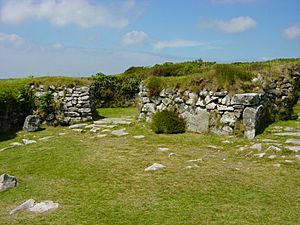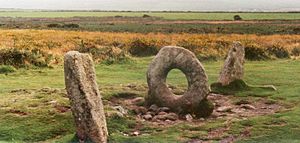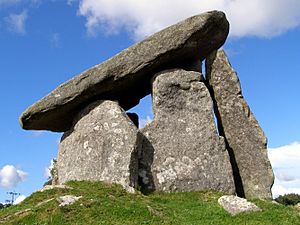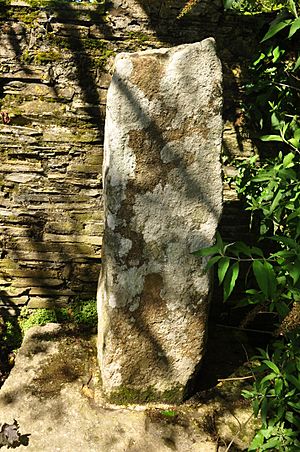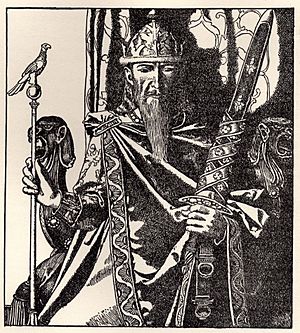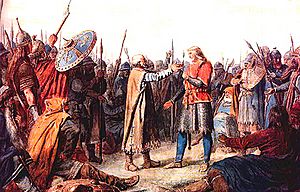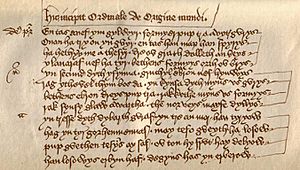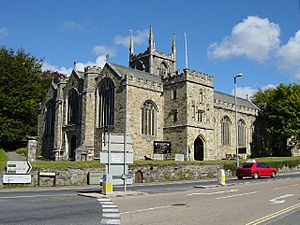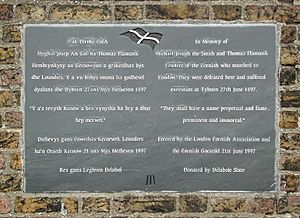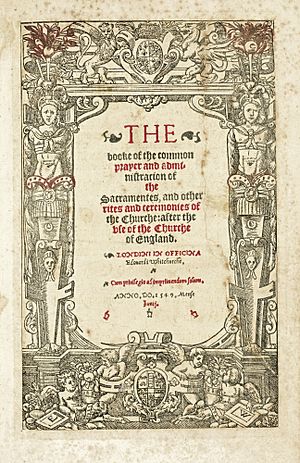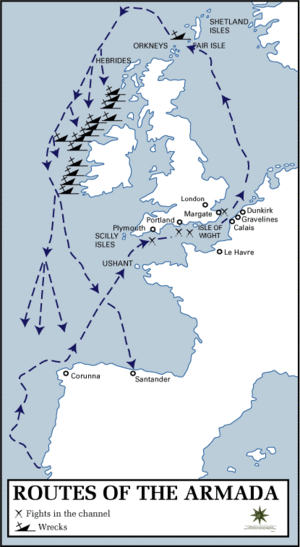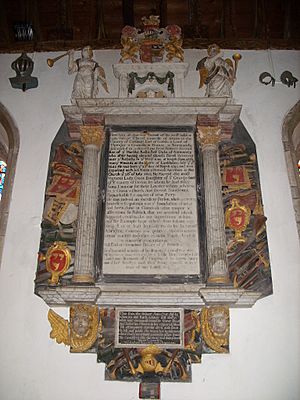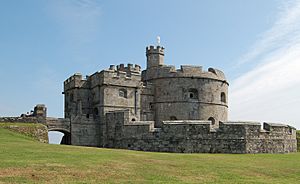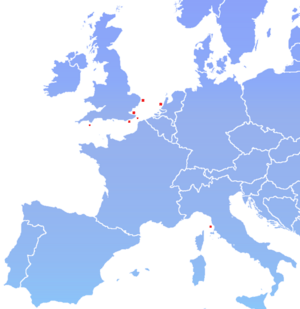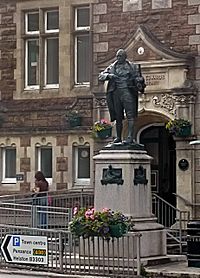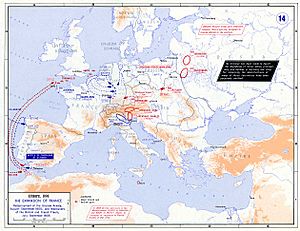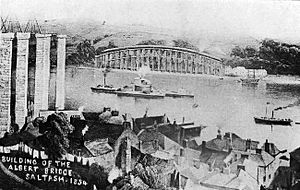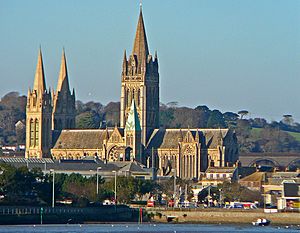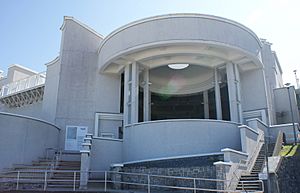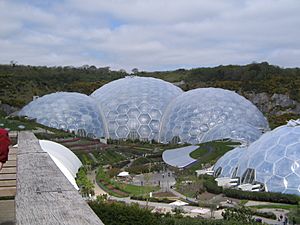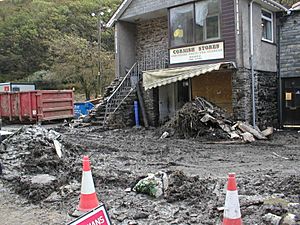Timeline of Cornish history facts for kids
The history of Cornwall is a long and exciting journey, stretching back thousands of years! This timeline will take you through the most important moments, from ancient times when people first mined tin, to the modern day. You'll discover how Cornwall became the unique place it is today, with its own language, culture, and strong sense of identity. Get ready to explore the past of this amazing land!
Contents
- Ancient Cornwall: Before the Romans Arrived
- Cornwall in the First Thousand Years
- Cornwall in the Second Thousand Years
- Norman Conquest and Cornish Identity (11th - 12th Centuries)
- Tin, Colleges, and Maps (13th - 14th Centuries)
- Literature, Rebellions, and Plagues (15th Century)
- Reformation and Language Decline (16th Century)
- Civil War and Language Loss (17th Century)
- Innovation and Methodism (18th Century)
- Railways, Mining, and Art (19th Century)
- Cornwall in the Modern Era
- Images for kids
- See also
Ancient Cornwall: Before the Romans Arrived
Early Life in Cornwall (4000 BC)
Long ago, people in Cornwall built amazing structures. You can still see examples like Chûn Quoit, Boscawen-Un, and Chysauster Ancient Village. These show us how people lived in the Stone Age, Bronze Age, and Iron Age. The first Cornish hedges, which are unique stone and earth walls, were also built around this time.
Tin Mining Begins (2000 BC)
Around 2150 BC, people started mining tin in Cornwall. It's believed that traders from the Mediterranean Sea visited Cornwall to get this valuable metal. Some historians think that the "Tin Islands" mentioned by the Greek writer Herodotus might have been Cornwall and the Isles of Scilly.
A Time of Trade and Iron (1600 BC - 750 BC)
By 1600 BC, Cornwall was booming thanks to its tin exports across Europe. Later, around 750 BC, the Iron Age arrived. This brought new tools like iron plows and axes, which made farming much easier and helped people grow more food.
Greek Explorers and Roman Arrival (330 BC - 55 BC)
Around 330 BC, a Greek explorer named Pytheas sailed around the British Isles. He wrote that the Cornish people were skilled farmers, peaceful, but also brave warriors. Later, in 60 BC, another Greek historian, Diodorus Siculus, called Cornwall "Belerion," meaning "The Shining Land." This is the first recorded name for a place in the British Isles! In 55 BC, the Roman general Julius Caesar tried to invade Britain. Over the next hundred years, the Romans slowly took control of Cornwall, which was then part of a larger area called Dumnonia.
Cornwall in the First Thousand Years
Roman Influence and Early Kingdoms (19 AD - 410 AD)
Even though the Romans didn't fully control Cornwall until later, their presence was felt. A Roman fort was built near Bodmin around 55–60 AD. This is one of the few Roman sites found in Cornwall. The name "Kernow," which is Cornwall's native name, was first recorded around 400 AD. It came from a Roman map that mentioned a "fortress of the Cornish people" near Tintagel. In 410 AD, the Roman Empire pulled its last soldiers out of Britain.
The Rise of Cornish Identity (5th Century)
After the Romans left, Cornwall's unique identity grew stronger. Many people from Cornwall and Devon moved to Brittany in France, creating a strong connection between the two regions. Legendary figures like King Mark, famous from the story of Tristan and Iseult, are believed to have ruled in Cornwall during this time, possibly from Tintagel.
Kingdoms and Christianity (6th Century)
Around the 6th century, the Kingdom of Cornwall began to form. This kingdom included the Dumnonii and Cornish Cornovii tribes. Christianity also started to spread in Cornwall much earlier than in Anglo-Saxon England. Many early Cornish saints came from Ireland, Wales, and Brittany, bringing their Christian faith.
Saxon Expansion and Cornish Resistance (7th - 9th Centuries)
The Anglo-Saxons, who would later form England, began to expand westward. In 577 AD, the Battle of Deorham separated the Cornish from the Welsh. Despite this, the Cornish fought hard to protect their land. In 682 AD, the King of Wessex pushed the Britons "as far as the sea." Battles like Llongborth (710 AD) and Hehil (722 AD) show the ongoing struggle. In 815 AD, King Egbert of Wessex attacked Cornwall "from east to west." Later, in 838 AD, the Cornish, allied with the Danes, were defeated at the Battle of Hingston Down. Despite these challenges, the Cornish language was still spoken, with the earliest known written Cornish appearing in the late 9th century.
Defining Borders and Viking Raids (10th Century)
In 927 AD, King Athelstan of Wessex is said to have expelled the Cornish from Exeter. However, in 936 AD, Athelstan set the River Tamar as Cornwall's eastern border. This meant Cornwall largely kept its independence, agreeing to pay tribute to the English king. The 10th century also saw Viking raids on the coast, with Padstow being attacked in 981 AD. In 997 AD, the Vikings destroyed Lydford, a town near the Cornish border, but left Cornwall itself alone.
Cornwall in the Second Thousand Years
Norman Conquest and Cornish Identity (11th - 12th Centuries)
In 1013 AD, the Danish army conquered Wessex, but they allowed Cornwall to remain self-governing in exchange for tribute. The Norman Conquest in 1066 AD brought many Bretons to Cornwall, and the Cornish and Breton languages were very similar at this time. After the conquest, Cornwall was given to Brian of Brittany, and later to Robert, Count of Mortain, who became the Earl of Cornwall. Even then, documents from the 12th century still referred to "Cornish and English" people, showing that Cornwall was seen as distinct.
Tin, Colleges, and Maps (13th - 14th Centuries)
Work began on the Lostwithiel Stannary Palace in 1265, a building for the Cornish tin industry. Glasney College was also founded in Penryn, becoming an important center for learning and Cornish culture. The Hereford Mappa Mundi, a famous map from around 1280, clearly showed Cornwall as a separate area. In 1307, the "Tinners Charter" was granted, giving special rights to tin miners. In 1336, Edward, the Black Prince, was named the first Duke of Cornwall, a title still held by the heir to the British throne today.
Literature, Rebellions, and Plagues (15th Century)
The 15th century saw the rise of popular Cornish literature, especially religious plays. Cornish archers even fought in the Battle of Agincourt in 1415. However, this period also brought challenges. In 1497, the Cornish Rebellion took place, protesting against taxes. Leaders like Michael An Gof and Thomas Flamank were executed. Plagues also affected Cornwall, causing hardship.
Reformation and Language Decline (16th Century)
In 1509, King Henry VIII's coronation procession included representatives from Cornwall, showing its distinct status. However, Henry VIII's break from the Catholic Church led to the English Reformation. In 1549, the Prayer Book Rebellion saw Cornish people rise up against the new English prayer book, which led to many deaths. This event, along with the enforcement of English, caused a decline in the use of the Cornish language. Despite this, some travelers noted that many people in Cornwall still spoke only Cornish. The Spanish Armada was sighted off St Michael's Mount in 1588, and Spanish forces even raided Mount's Bay in 1595.
Civil War and Language Loss (17th Century)
In 1603, the Venetian ambassador noted that Queen Elizabeth I ruled over five different "peoples": English, Welsh, Cornish, Scottish, and Irish. During the English Civil War (1642–1646), Cornwall was a strong supporter of the King. The Cornish saw it as a fight for their own rights and privileges. Battles like Braddock (1643) and Stratton (1643) were Cornish Royalist victories. King Charles I even thanked the people of Cornwall for their support. However, after the Royalists lost the war, Pendennis Castle, a Royalist stronghold, surrendered in 1646. By 1676, Chesten Marchant, believed to be the last person who spoke only Cornish, passed away.
Innovation and Methodism (18th Century)
The 18th century brought important changes. In 1743, John Wesley visited Cornwall, and Methodism became very popular over the next hundred years. Richard Trevithick, a famous inventor, was born in Cornwall in 1771. He would later build the first full-size steam road carriage. Sadly, Dolly Pentreath, often called the last fluent native speaker of Cornish, died in 1777.
Railways, Mining, and Art (19th Century)
The 19th century was a time of great change. Richard Trevithick built his steam road carriage in 1801. The Davy lamp, invented by Sir Humphry Davy in 1815, made mining safer. The Cornwall Railway began construction in 1852, and the impressive Royal Albert Bridge opened in 1859, connecting Cornwall to the rest of Britain by rail. Mining was still very important, but disasters like East Wheal Rose (1846) and Dolcoath (1893) showed the dangers. In the 1880s, artists' colonies were established in Newlyn, Lamorna, and St Ives, making Cornwall a hub for art. In 1876, Cornwall became its own diocese again, with Truro Cathedral completed in 1910.
Cornwall in the Modern Era
Recognition and Revival (20th Century)
In 1904, Cornwall was accepted into the Celtic Congress, showing a growing interest in its Celtic heritage. Henry Jenner published his "Handbook of the Cornish language," helping to revive it. The first Old Cornwall Society was founded in 1920, and the Gorseth Kernow, a festival celebrating Cornish culture, began in 1928. In 1951, the Cornish political party, Mebyon Kernow, was formed to champion Cornish interests. In 1962, the Goonhilly Receiving Station opened, receiving the first transatlantic TV broadcast. The 1967 Torrey Canyon supertanker disaster caused severe environmental damage to the coast. In 1993, the Tate St Ives art gallery opened, further boosting Cornwall's art scene. South Crofty, a major tin mine, closed in 1998, marking the end of a long mining era.
A New Millennium for Cornwall (21st Century)
The 21st century started with the opening of the Eden Project in 2001, a huge environmental attraction. In the same year, 50,000 people signed a declaration for a Cornish Assembly, showing strong support for more local control. The Cornish language was officially recognized by the government in 2002. In 2004, Boscastle experienced a severe flood. In 2014, the UK Government officially recognized the Cornish people as a distinct national group, giving them special protection. In 2021, Cornwall hosted the 47th G7 summit, bringing world leaders to Carbis Bay.
Images for kids
See also


